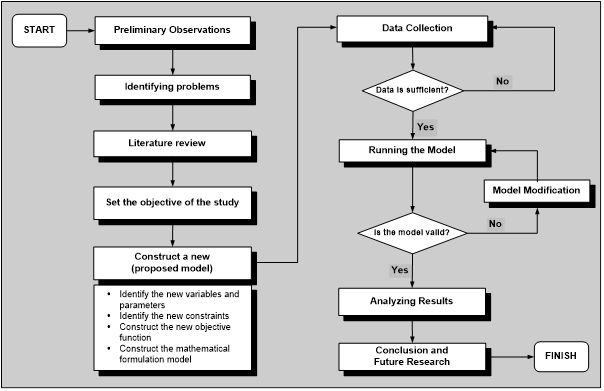The MILP Model for Locating the Temporary Disaster Emergency Operation Centers in Manado Indonesia
DOI:
https://doi.org/10.22219/JTIUMM.Vol21.No1.46-57Keywords:
Disaster management, Disaster relief, Flood emergency response, MILP model, Temporary facility locationAbstract
The research proposes the Mixed Integer Linear Programming Model (MILP). This model integrates the location decisions and the number of temporary Emergency Operations Center (EOC) to be constructed. This model also focuses on events related to natural disasters, particularly floods. The researchers applied this model according to the flood scenario in five flood-prone districts in Manado, Indonesia. This research focused on maximizing the number of temporary constructed EOCs to provide the relief demands of disaster areas by considering multiple periods. The available budgets were considered as the limited constraints in this model. Therefore, the results showed that the percentage of relief demand satisfaction ranges from 28% to 100%; meanwhile, the number of the to-be-constructed temporary EOCs ranges from 0-3 for each scenario.
Downloads
References
[1] R. Riyandari, ""Water Front City” Mitigasi Bencana Banjir Di Kelurahan Dendengan Luar, Kota Manado," Jurnal Sains dan Teknologi Mitigasi Bencana, vol. 13, pp. 57-64, 2018. https://doi.org/10.29122/jstmb.v13i1.3361.
[2] B. Laurensz, F. Lawalata, and S. Y. J. Prasetyo, "Potensi Resiko Banjir dengan Menggunakan Citra Satelit (Studi Kasus: Kota Manado, Provinsi Sulawesi Utara)," Indonesian Journal of Computing and Modeling, vol. 2, pp. 17-24, 2019. https://ejournal.uksw.edu/icm/article/view/2536.
[3] A. Rinaldi, D. Pohan, and I. Moe, Evaluasi Permasalahan Banjir Kota Manado Dengan Pemodelan Dua Dimensi, 2018. https://doi.org/10.13140/RG.2.2.28625.79205.
[4] N. SP. (January 22, 2014, march 01). Update Banjir Bandang Manado.
[5] G. B. Sahetapy and H. Poli, "Analisis Jalur Evakuasi Bencana Banjir Di Kota Manado," SPASIAL, vol. 3, pp. 70-79, 2016. https://ejournal.unsrat.ac.id/index.php/spasial/article/view/12536.
[6] Y. Sudamara, B. F. Sompie, and R. J. Mandagi, "Optimasi penanggulangan bencana banjir Di kota manado dengan metode AHP (analytical hierarchy process)," Jurnal Ilmiah Media Engineering, vol. 2, 2012. https://ejournal.unsrat.ac.id/index.php/jime/article/download/4247/3776.
[7] P. F. Opit, "A MILP Model for Locating the Temporary Disaster Emergency Operations Centers in Manado Indonesia," 2020, vol. 21, 2020. https://ejournal.umm.ac.id/index.php/industri/article/view/10165.
[8] N. Altay and W. G. Green, "OR/MS research in disaster operations management," European Journal of Operational Research, vol. 175, pp. 475-493, 2006. https://doi.org/10.1016/j.ejor.2005.05.016.
[9] G. Galindo and R. Batta, "Review of recent developments in OR/MS research in disaster operations management," European Journal of Operational Research, vol. 230, pp. 201-211, 2013. https://doi.org/10.1016/j.ejor.2013.01.039.
[10] N. Tungtisanont, A. V. Roth, Y. B. Ferrand, and T. A. Mroz, "Disaster Operations Management: an Empirical Study from Thailand," 2015. www.tigerprints.clemson.edu/cgi/viewcontent.cgi?article=1159&context=grads_symposium.
[11] C. Boonmee, M. Arimura, and T. Asada, "Facility location optimization model for emergency humanitarian logistics," International Journal of Disaster Risk Reduction, vol. 24, pp. 485-498, 2017. https://doi.org/10.1016/j.ijdrr.2017.01.017.
[12] A. Sebatli, F. Cavdur, and M. Kose-Kucuk, "Determination of relief supplies demands and allocation of temporary disaster response facilities," Transportation Research Procedia, vol. 22, pp. 245-254, 2017. https://doi.org/10.1016/j.trpro.2017.03.031.
[13] D. W. Khayal, "Dynamic Locations Of Temporary Distribution Facilities For Emergency Response Planning," Qatar University, 2015.
[14] W. Yu, "Reachability guarantee based model for pre-positioning of emergency facilities under uncertain disaster damages," International Journal of Disaster Risk Reduction, vol. 42, p. 101335, 2020. https://doi.org/10.1016/j.ijdrr.2019.101335.
[15] A. M. Caunhye, X. Nie, and S. Pokharel, "Optimization models in emergency logistics: A literature review," Socio-Economic Planning Sciences, vol. 46, pp. 4-13, 2012. https://doi.org/10.1016/j.seps.2011.04.004.
[16] N. Görmez, M. Köksalan, and F. S. Salman, "Locating disaster response facilities in Istanbul," Journal of the Operational Research Society, vol. 62, pp. 1239-1252, 2011. https://doi.org/10.1057/jors.2010.67.
[17] İ. Akgün, F. Gümüşbuğa, and B. Tansel, "Risk based facility location by using fault tree analysis in disaster management," Omega, vol. 52, pp. 168-179, 2015. https://doi.org/10.1016/j.omega.2014.04.003.
[18] C. Boonmee, M. Arimura, and T. Asada, "Location and allocation optimization for integrated decisions on post-disaster waste supply chain management: On-site and off-site separation for recyclable materials," International Journal of Disaster Risk Reduction, vol. 31, pp. 902-917, 2018. https://doi.org/10.1016/j.ijdrr.2018.07.003.
[19] H. Baharmand, T. Comes, and M. Lauras, "Bi-objective multi-layer location–allocation model for the immediate aftermath of sudden-onset disasters," Transportation Research Part E: Logistics and Transportation Review, vol. 127, pp. 86-110, 2019. https://doi.org/10.1016/j.tre.2019.05.002.
[20] P. Memari, R. Tavakkoli-Moghaddam, M. Partovi, and A. Zabihian, "Fuzzy Dynamic Location-Allocation Problem with Temporary Multi-Medical Centers in Disaster Management," IFAC-PapersOnLine, vol. 51, pp. 1554-1560, 2018. https://doi.org/10.1016/j.ifacol.2018.08.275.
[21] W. Yi and L. Özdamar, "A dynamic logistics coordination model for evacuation and support in disaster response activities," European Journal of Operational Research, vol. 179, pp. 1177-1193, 2007. https://doi.org/10.1016/j.ejor.2005.03.077.
[22] A. Kawasaki, N. Ichihara, Y. Ochii, R. A. Acierto, A. Kodaka, and W. W. Zin, "Disaster response and river infrastructure management during the 2015 Myanmar floods: A case in the Bago River Basin," International Journal of Disaster Risk Reduction, vol. 24, pp. 151-159, 2017. https://doi.org/10.1016/j.ijdrr.2017.06.004.
[23] A. B. Milburn, C. Rainwater, O. Boudhoum, and S. Young, "Models for Disaster Relief Shelter Location and Supply Routing," 2013. https://rosap.ntl.bts.gov/view/dot/26064.
[24] C. Mejia-Argueta, J. Gaytán, R. Caballero, J. Molina, and B. Vitoriano, "Multicriteria optimization approach to deploy humanitarian logistic operations integrally during floods," International Transactions in Operational Research, vol. 25, pp. 1053-1079, 2018. https://doi.org/10.1111/itor.12508.
[25] O. Rodríguez-Espíndola, P. Albores, and C. Brewster, "GIS and optimisation: potential benefits for emergency facility location in humanitarian logistics," Geosciences, vol. 6, p. 18, 2016. https://doi.org/10.3390/geosciences6020018.
[26] A. Muhammad Zainul Abror and S. S. Jumadi, "Analisis Penentuan Lokasi Potensial Shelter Evakuasi dan Desain Evakuasi untuk Bencana Banjir di Kelurahan Sumber, Kecamatan Banjarsari," Universitas Muhammadiyah Surakarta, 2019. https://eprints.ums.ac.id/id/eprint/72105.
[27] P. F. Opit and K. Nakade, "Pre-positioning of Emergency Relief Supplies under Facility Disruptions," 대한산업공학회 추계학술대회 논문집, pp. 3109-3114, 2015. www.dbpia.co.kr/Journal/articleDetail?nodeId=NODE06561271.
[28] W. Klibi, S. Ichoua, and A. Martel, "Prepositioning emergency supplies to support disaster relief: a case study using stochastic programming," INFOR: Information Systems and Operational Research, vol. 56, pp. 50-81, 2018. https://doi.org/10.1080/03155986.2017.1335045.
[29] Ç. Renkli and S. Duran, "Pre-Positioning Disaster Response Facilities and Relief Items," Human and Ecological Risk Assessment: An International Journal, vol. 21, pp. 1169-1185, 2015. https://doi.org/10.1080/10807039.2014.957940.
[30] C. G. Rawls and M. A. Turnquist, "Pre-positioning and dynamic delivery planning for short-term response following a natural disaster," Socio-Economic Planning Sciences, vol. 46, pp. 46-54, 2012. https://doi.org/10.1016/j.seps.2011.10.002.
[31] R. Abounacer, M. Rekik, and J. Renaud, "An exact solution approach for multi-objective location–transportation problem for disaster response," Computers & Operations Research, vol. 41, pp. 83-93, 2014. https://doi.org/10.1016/j.cor.2013.08.001.

Downloads
Published
How to Cite
Issue
Section
License
Copyright (c) 2020 Andre Ch. Lasut, Prudensy Febreine Opit, Ronaldo Rottie

This work is licensed under a Creative Commons Attribution-ShareAlike 4.0 International License.











